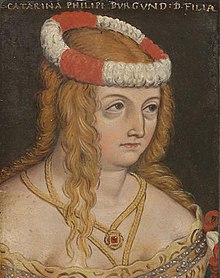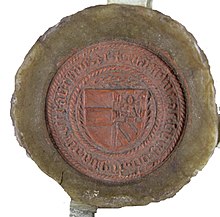Catherine of Burgundy
Catherine of Burgundy (* 1378 ; † January 26, 1425 in Dijon ) was a duchess of Austria by marriage and ruled over parts of the " Austrian foreland " as a widow .
Origin, family and marriage
Catherine was a daughter of Duke Philip II of Burgundy from his marriage to Countess Margaret of Flanders . She was married to Duke Leopold IV of Austria . She had no children from this marriage. The fact that after Leopold's death around 1414 she actually married the baron Maximilian S Maßmann (Maximin S Maßmann) I. von Rappoltstein (line Rappoltstein and Hohenack) (* 1382 or 1383; † around 1451) is considered a fact in older secondary literature , but has not yet been clearly proven.
Katharina's marriage to Leopold of Austria
Originally a marriage between Duke Leopold IV of Austria and Margaret of Burgundy, an older sister of Katharina, was planned. This did not materialize. At the end of 1384 the first discussions about a marriage with Katharina were held. The wedding between her and Leopold was initially planned for September 29, 1385, but had to be postponed several times for various reasons and ultimately only took place between September 14 and 17, 1387 in Dijon in the presence of the groom. It was not until a few years later, on September 18, 1393, that Katharina began the trip to see her husband. According to some statements from Katharina, the relationship between the couple should have been quite good.
Catherine's rule in Alsace
Katharina had received a dowry of 100,000 gold francs or guilders from her father. However, the payment of this sum caused difficulties and resulted in years of negotiations. Leopold IV prescribed the county of Pfirt to her as a reserve for her dowry .
After the consummation of the marriage, Katharina managed to obtain extensive concessions and to keep her marriage property and her morning gift in her own hands. She now resided in Alsace near her parents and later her brother, Duke John of Burgundy. One of her preferred residences was in Ensisheim , where, like in Thann , she initially had her widow's residence after 1411. Katharina built up a parallel structure to the administration in the county of Pfirt, which she had found there and which was subordinate to a governor. This was sometimes poorly received by the local nobility. In 1409 Katharina waged war with the city of Basel , and a year later an alliance was formed.
Katharina's fight for her rule
After Leopold's death in 1411 Catherine was against their opponents in the Alsatian nobility first support for his brother and successor, Frederick IV. To 1414 but it came between her, Frederick IV. And his brother Ernst I. conflict. Obviously, the Dukes of Austria feared that Katharina intended to establish her own dynasty with a second husband at the expense of the House of Austria. In addition, Duke John of Burgundy may have planned to bring the county of Pfirt, which was ruled by his sister, under his own rule. The events at the Council of Constance and the politics of King Siegmund may not have been directed against Katharina, who tried to secure his support against the House of Austria, or her rule in Alsace, but had the consequence that she was badly shaken and Katharina finally retired to Burgundy. Around 1421 there was an agreement between the Austrian and Burgundian dukes, only then did Katharina return to her county.
Death and consequences
It seems that Catherine stayed mostly in Burgundy during the last years of her life. After her death she was buried in the Champmol Charterhouse near Dijon.
She left a will in favor of her nephew, Duke Philip III. whom she had appointed as her sole heir. Ultimately, however, this could not prevent Duke Friedrich IV. After Katharina's death, from asserting his rule over the county of Pfirt.
Katharina's marriage plans with Maximilian S Maßmann von Rappoltstein
After the death of her husband, the woman from Burgundy, described as very stout, is said to have entered into a second marriage to Maximilian S Maßmann von Rappoltstein in 1414, from which she also had no descendants. According to the more recent secondary literature, it has by no means been proven that this second marriage was actually concluded, so it could have remained just a marriage promise. Duke John of Burgundy is said to have negotiated with Maximilian S Maßmann in 1418 or 1419 in order to bring about a solution to the given vows or the dissolution of the marriage, which should have happened in 1421, which shows that Katharina's marriage project was neither supported by the Dukes of Austria nor was well received by the Dukes of Burgundy. However, it is also possible that this marriage was just an idea that was not pursued, or that this marriage story was invented by Katharina's opponents in order to harm her politically.
Little is known about Baron Maximilian S Maßmann von Rappoltstein. He belonged to the imperial nobility and worked several times for the dukes of Austria as governor in Alsace. In 1407, Duchess Katharina made him her bailiff in Alsace, Sundgau and Breisgau , but already deposed him in November of the same year when there were differences regarding the accounting. However, this did not prevent her from transferring the bailiwick to him again in 1414 after Duke Friedrich IV., With whom she was in conflict at the time, had already occupied it with another person. Duke Friedrich IV. In turn had commissioned S Maßmann on June 29, 1412 with a diplomatic mission to the King of France and the Duke of Burgundy. In the event of a successful fulfillment of this, he held out the prospect of entrusting him with the governor of Alsace. But it was not until 1430 or 1432 that Frederick IV actually made S Maßmann his governor in Alsace, Sundgau, Breisgau and the Black Forest, as well as for the cities of Villingen , Waldshut , Laufenburg and Säckingen , an office that S Maßmann held until 1437. His experiences as bailiff show that S Maßmann obviously knew how to move between the two fronts. In 1422 S Maßmann led a feud with Count Hans von Lupfen against Hans Wilhelm von Girsberg, who was killed while conquering his castle . As a result, this castle came to the Lords of Rappoltstein as a completed fief. In 1434 S Maßmann bought the Pflixburg from Kaspar Schlick .
literature
- Klaus Brandstätter: The Tyrolean princesses in the 15th century . In: Margarete Maultasch. The world of a princess and other Tyrolean women of the Middle Ages. Edited by Julia Hörmann-Thurn and Taxis. 2007 (= Schlern-Schriften 339), pp. 211–217
- Eva Bruckner: Forms of representation of power and self-portrayal of Habsburg princes in the late Middle Ages , phil. Dissertation, Vienna, 2009, p. 174 and p. 175
Lexica articles
- Constantin von Wurzbach : Habsburg, Catherine of Burgundy . In: Biographisches Lexikon des Kaiserthums Oesterreich . 6th part. Imperial and Royal Court and State Printing Office, Vienna 1860, p. 401 ( digitized version ).
- Brigitte Hamann: The Habsburgs. A biographical lexicon . Verlag Carl Ueberreuter, Vienna, 1988, p. 234 f.
Fiction
- Norbert Fichtlscherer: Catherine of Burgundy - perseverance until death . UGS Verlag Badenweiler, 2010 (book presentation, in: Badische Zeitung, November 30, 2010 )
Web links
- Noble database of the University of Erlangen
- http://www.burg-badenweiler.de/wissenswert-amuesant/persoenitäten/katharina-von-burgund/ , accessed on March 26, 2017
Individual evidence
- ↑ another date of death: January 29, 1426, according to Klaus Brandstätter: Die Tiroler Landesfürstinnen in the 15th century. In: Margarete Maultasch. The world of a princess and other Tyrolean women of the Middle Ages. Edited by Julia Hörmann-Thurn and Taxis. 2007 (= Schlern-Schriften 339), p. 217
- ↑ Michael Bärmann: Antonius von Pforr and the gentlemen of Schönau . In: Daphnis, Journal for Middle German Literature and Culture of the Early Modern Age (1400-1750) , 2006, Vol. 35, H. 1-2, P. 7 (footnote)
- ↑ cf. Klaus Brandstätter: The Tyrolean princesses in the 15th century. 2007, p. 215
- ^ Eva Bruckner: Formen der Herrschaftsrepresentation , 2009, p. 174
- ^ Eva Bruckner: Formen der Herrschaftsrepresentation , 2009, p. 174
- ↑ Konstantin Moritz A. Langmaier: Archduke Albrecht VI. of Austria (1418–1463). A prince in the field of tension between dynasty, regions and empire (= research on the imperial and papal history of the Middle Ages. Vol. 38). Böhlau, Cologne a. a. 2015, ISBN 978-3-412-50139-6 (Partly at the same time: Munich, Ludwig-Maximilians-Universität, dissertation, 2013), p. 376
- ^ Eva Bruckner: Forms of representation of power and self-portrayal of Habsburg princes in the late Middle Ages , phil. Dissertation, Vienna, 2009, p. 165
- ↑ Ute Monika Schwob: "Mistresses" in Tyrolean sources. On the legal and social position of noble women in the Middle Ages , in: Egon Kühebacher (Hrsg.): Literature and fine arts in the Tyrolean Middle Ages. The Iwein frescos by Rodenegg and other evidence of the interaction between literature and the fine arts (= Innsbruck contributions to cultural studies. Germanistic series 15), Innsbruck 1982, p. 170
- ^ Eva Bruckner: Formen der Herrschaftsrepresentation , 2009, p. 175
- ↑ Konstantin Moritz A. Langmaier: Archduke Albrecht VI. of Austria (1418–1463). A prince in the field of tension between dynasty, regions and empire (= research on the imperial and papal history of the Middle Ages. Vol. 38). Böhlau, Cologne a. a. 2015, ISBN 978-3-412-50139-6 (partly at the same time: Munich, Ludwig-Maximilians-Universität, dissertation, 2013), p. 376f., Assumes that the conflict over Katharina's dowry was not settled until 1454, but there are currently no written documents.
- ^ Klaus Brandstätter: The Tyrolean sovereigns in the 15th century. In: Margarete Maultasch. The world of a princess and other Tyrolean women of the Middle Ages. Edited by Julia Hörmann-Thurn and Taxis. 2007 (= Schlern-Schriften 339), p. 215
- ^ Rolf Köhn: The governor in the late medieval foreland . Creature of the duke and tyrant of the subjects? In: Franz Quarthal - Gerhard Faix (Hrsg.): The Habsburgs in the German Southwest . New research on the history of Upper Austria. Stuttgart, Thorbecke, 2000, p. 160 f., P. 161 and p. 169 (footnote)
- ↑ Cf. Thomas Biller - Bernhard Metz: The late Romanesque castle building in Alsace (1200 - 1250). (= The castles of Alsace. Architecture and history, Volume 2). Munich / Berlin 2007, p. 385.
| personal data | |
|---|---|
| SURNAME | Catherine of Burgundy |
| BRIEF DESCRIPTION | Wife of Duke Leopold IV of Austria; Ruler in the Habsburg foothills; Duchess of Burgundy |
| DATE OF BIRTH | 1378 |
| DATE OF DEATH | January 26, 1425 |
| Place of death | Dijon |

